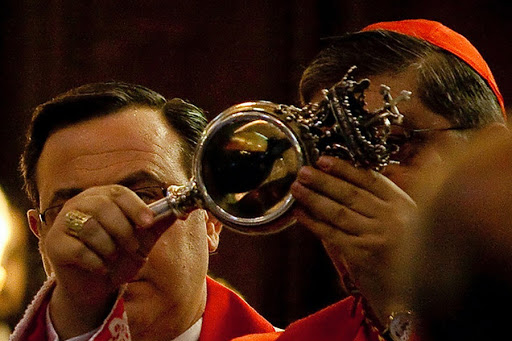As Naples awaits Pope Francis’ imminent arrival, many Neapolitan faithful are hoping that the miracle of St. Gennaro — the mysterious liquifying of the ancient relic of the blood of Naples’ protector and patron — will occur during the Pope’s one-day visit on Saturday.
If the miracle occurs, it would be the first time the blood relic liquifies in the presence of a pontiff since Pope Pius IX.
The mysterious phenomenon has rarely occurred outside the “canonical” date: the saint’s blood, for example, did not liquify when Pope Benedict XVI and Pope St. John Paul II visited Naples’ Cathedral to venerate the the saint’s relics.
Who is St. Gennaro? Also known in English as St. Januarius, he was Bishop of Naples and is a saint and martyr of the Roman Catholic and Eastern Orthodox Churches. Historical sources claim he was martyred in the year 305 during the Diocletian persecution.
According to legend, St. Gennaro’s blood was saved by a woman called Eusebia just after his death. The practice of gathering blood for relics was a common practice beginning in the days of persecution when the early Christians soaked cloths in the blood shed by martyrs or, if possible, actually collected the liquid in flasks to keep as devotional items. In the catacombs these flasks were buried with the dead. Their discovery indicated that the person had died a martyr.
The miracle of St. Gennaro occurs each year on September 19, the Catholic liturgical feastday which commemorates the anniversary of the saint’s martyrdom.
The dried blood of the St. Gennaro, which is preserved in two glass phials in the Naples Cathedral, traditionally liquefies three times a year. As well as the anniversary of the saint’s beheading, the miracle also takes place on December 16, the date of the eruption of Mt. Vesuvius in 1631 which was believed to have been halted through the saint’s intervention. The miracle also occurs again on the Saturday before the first Sunday in May.
Whether the liquifying blood miracle takes place or not, Pope Francis’ visit to Naples and Pompeii aims to be one deep significance, expressing solidarity with the poor and afflicted in a city notorious for organized crime.
Unlike previous papal visit of recent times, this Lenten trip will be markedly less festive, so much so that plans of Cardinal Crecenzio Sepe, the Archbishop of Naples, to stage two large concerts during the visit were reportedly shelved on the Vatican’s instructions.
The one-day visit begins at 8am, when the Pope arrives by helicopter from the Vatican at the Virgin of the Rosary Shrine of Pompeii.
An hour later, he will arrive in Scampia, an impoverished area close to Naples, where he will meet with various social groups in the St. John Paul II Square. Francis will then celebrate Mass in Naples’ central Piazza del Plebiscito.
He will then have lunch with prison inmates, who include AIDS sufferers and transgender detainees, in the “Giuseppe Salvia” Detention Centre in Poggioreale. Afterwards, he will venerate the relics of St. Gennaro and meet with local clergy and religious in the city’s cathedral.
Before departing for the Vatican at approximately 6 p.m., Pope Francis will greet the sick in the Basilica del Gesù, followed by a meeting with young people on the Caracciolo sea-front.
As many as three million people are expected to turn out to see the Pope, and Church sources say some 1,500 volunteers have been recruited to assist pilgrims. Hundreds of church bells will ring to mark his arrival and a large 1,500-member choir will sing at Mass in Piazza del Plebiscito.
This will be the Pope’s second visit to the Campania region in 12 months.
St. John Paul II visited Pompeii and Naples in October 1979 and October 2003. Pope Benedict XVI made a pastoral visit in October, 2007. In his homily, he addressed the social problems of the region by saying that the “power that changes the world and transforms it into the Kingdom of God, in silence and without fanfare, is faith – and prayer is the expression of faith.”
He added: “Faith and hope open earth to divine power.”
Security will be tight for Saturday’s visit after the terrorist attacks in Tunisia this week with more than 3,000 police and firefighters on duty for the visit.
Diane Montagna is Rome correspondent for Aleteia’s English edition.

